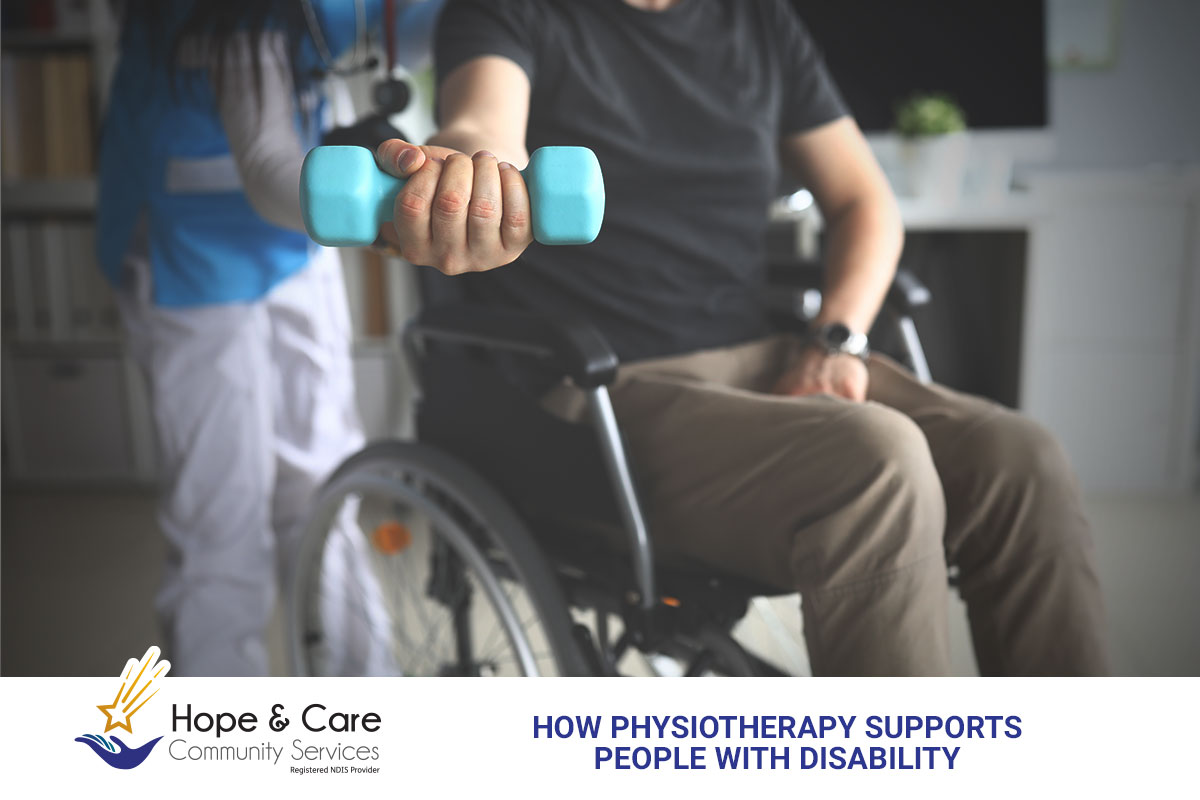
Physiotherapy is essential for individuals with disabilities, helping them improve mobility, manage pain and enhance their quality of life. Through targeted exercises, hands-on therapy and assistive technologies, physiotherapists provide the necessary support for people to regain independence and participate in daily activities.
At Hope & Care Community Services (HCCS), a trusted NDIS-registered provider, we understand how physiotherapy empowers individuals with disabilities. In this article, we explore the benefits of physiotherapy, common treatment techniques and how it contributes to a holistic approach to disability support.
What Is Physiotherapy?
Physiotherapy, or physical therapy, is a healthcare discipline that helps individuals recover movement, strength and function after an injury, illness, or disability. Physiotherapists assess a person’s physical challenges and create individualised treatment plans that may include:
- Manual therapy – Hands-on techniques such as massage and joint mobilisation
- Therapeutic exercises – Stretching and strengthening activities to improve mobility
- Assistive devices – Mobility aids like wheelchairs, prosthetics and orthotics
- Education and self-management – Training on posture, body mechanics and energy conservation
For people with disabilities, physiotherapy is a crucial component of NDIS support services, enabling them to live more independently and participate in their communities.
Benefits of Physiotherapy for People with Disabilities
Improves Mobility and Independence
Many individuals with disabilities struggle with movement, which can limit their ability to perform daily tasks. Physiotherapy provides:
- Personalised exercise programs to strengthen muscles and improve coordination
- Mobility training to help individuals walk, transfer, or use mobility aids safely
- Postural adjustments to enhance stability and prevent discomfort
As a result, individuals gain greater freedom to move, reducing their reliance on caregivers and improving their overall independence.
Reduces and Manages Pain
People with disabilities often experience chronic pain due to muscle imbalances, joint stiffness, or nerve-related conditions. Physiotherapy helps by:
- Using manual therapy techniques, such as massage and stretching, to relieve tension
- Incorporating hydrotherapy, where water reduces strain on joints while allowing movement
- Applying heat and cold therapy to ease inflammation and promote relaxation
By addressing the root cause of pain, physiotherapy allows individuals to move more comfortably without over-relying on pain medication.
Prevents Secondary Health Complications
Individuals with limited mobility or neurological conditions are at risk of developing additional health issues, such as:
- Pressure sores, caused by prolonged sitting or lying down
- Joint contractures, where joints become stiff due to inactivity
- Respiratory infections, common in individuals with reduced lung function
Physiotherapy reduces these risks by:
- Teaching proper positioning techniques to prevent sores and pressure injuries
- Using range-of-motion exercises to maintain flexibility and prevent stiffness
- Providing breathing exercises to improve lung capacity and circulation
By taking preventative measures, physiotherapy enhances long-term health and reduces hospital visits.
Enhances Balance and Coordination
Many disabilities affect balance and coordination, making movement unsafe. Physiotherapy improves stability through:
- Fall prevention training, which strengthens muscles used for standing and walking
- Gait training, which teaches individuals safe and efficient walking techniques
- Core strengthening exercises, which improve posture and body control
With better balance, individuals can move around safely and confidently, reducing their risk of injury.
Supports Participation in Recreational and Social Activities
Physical activity is vital for mental well-being, confidence and social interaction. Physiotherapy enables people with disabilities to enjoy hobbies, sports and social activities by:
- Identifying adaptive sports and activities suited to their abilities
- Providing strength and endurance training to improve physical stamina
- Teaching safe movement techniques to minimise injury risks
By staying active, individuals experience improved mood, reduced stress and a greater sense of inclusion in their communities.
Common Physiotherapy Techniques for Disability Support
Physiotherapists use evidence-based techniques tailored to each person’s needs. Some of the most effective methods include:
Therapeutic Exercises
These exercises help individuals:
- Strengthen weak muscles
- Improve flexibility and range of motion
- Increase cardiovascular fitness and stamina
Regular physical activity builds strength for daily tasks and long-term independence.
Manual Therapy
This includes:
- Joint mobilisation to improve flexibility
- Soft tissue therapy to release muscle tightness
- Trigger point therapy to relieve pain in specific areas
Manual therapy is especially beneficial for stiffness, pain, or restricted movement.
Assistive Technology and Mobility Aids
Physiotherapists provide training on the use of:
- Wheelchairs and walking frames
- Prosthetics and orthotics
- Adaptive seating and positioning equipment
Proper use of these aids enhances mobility and prevents strain or injury.
Hydrotherapy
Hydrotherapy uses warm water to support movement and reduce pain. It is particularly helpful for individuals with:
- Muscle weakness
- Joint stiffness
- Chronic pain conditions
Because water provides buoyancy and resistance, hydrotherapy allows individuals to exercise with less stress on their joints.
Education and Self-Management
Physiotherapists also teach individuals:
- How to maintain good posture to prevent strain
- How to conserve energy and avoid fatigue
- Strategies to prevent future injuries
By learning these skills, individuals become more independent and confident in managing their condition.
The Importance of a Multidisciplinary Approach
Physiotherapy works best when combined with a holistic support plan. Physiotherapists collaborate with:
- Support workers, who help integrate therapy into daily routines
- Occupational therapists, who improve daily living skills
- Speech therapists, who support individuals with neurological conditions
- Medical professionals, who oversee overall health care
Conclusion
Physiotherapy provides life-changing benefits for individuals with disabilities, helping them improve mobility, reduce pain and prevent complications. Through personalised treatment plans, physiotherapists empower people to move more freely, participate in daily activities and stay engaged in their communities.
For NDIS participants, physiotherapy can be included in their NDIS plan to ensure ongoing support and long-term benefits. At Hope & Care Community Services, we can assist in finding the right services that align with individual needs and goals. By embracing physiotherapy as part of a holistic care plan, individuals with disabilities can achieve greater independence, improved health and a better quality of life.
Want to learn more? Read other articles :
- Redefine Independence your own way – with HCCS
- Who’s Who: The Key Terms of Your NDIS Plan
- Foundational Supports: Building Blocks of NDIS Success
HCCS is a registered NDIS provider. Learn more about our services.
♥ We are available in Brisbane! – Our team is just a call away!
